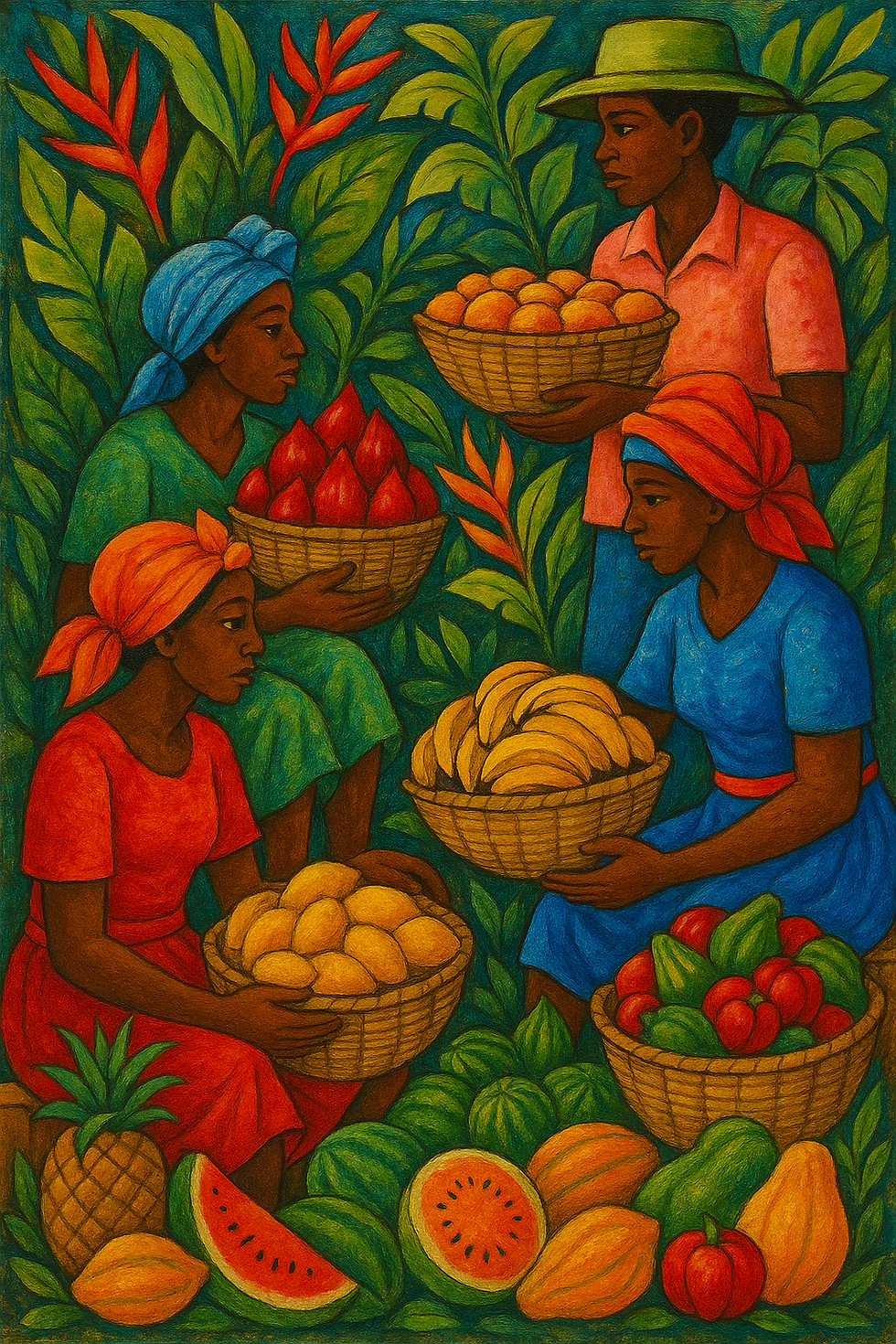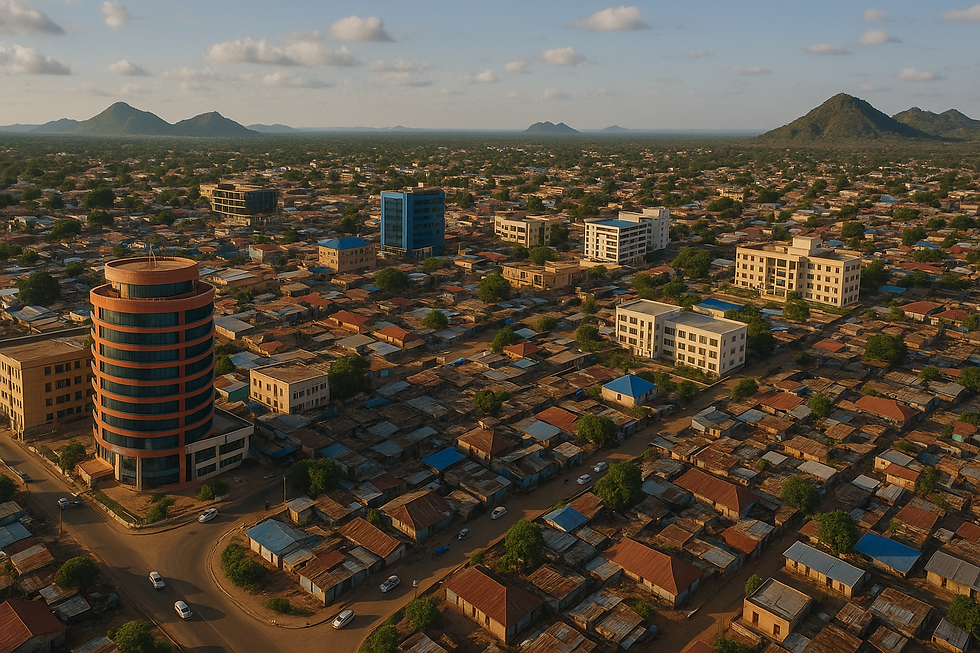Between Earthquake and Exodus: Haiti’s ESG Struggle for Stability, Sovereignty, and Climate Resilience
- tinchichan

- Aug 8
- 5 min read
In the hills above Port-au-Prince, the sun rises over a city fraying at the edges. Amid the sound of roosters and distant gunfire, Haiti wakes to another day of uncertainty—governed not by elected officials, but by resilience, remittances, and resolve. The country has no functioning parliament, no regular elections, no armed forces. What it does have are 13 million people navigating the aftermath of disaster, dictatorship, and dependence—with climate change now adding a cruel urgency.
Haiti is the most climate-vulnerable country in the Western Hemisphere. It is also among the poorest, the most deforested, and the most politically fragile. And yet, within this crucible of crisis, a quiet ESG story is emerging—one defined less by compliance than by survival, less by frameworks than by frontline adaptation.

“ESG in Haiti is not about metrics. It’s about whether a child can go to school without walking past burning tires. Whether a woman can access clean water and safety. Whether a hillside can hold during the next storm,” says a local development expert in Cap-Haïtien.
1. ESG in Context: A Republic on the Edge
GDP (2024 est.): $14.6 billion (PPP)
Population: ~11.7 million
GDP per capita (nominal): ~$1,300
Poverty rate: ~60%
Inflation (2024 est.): ~25%
Public debt-to-GDP: ~25%
Remittances: ~24% of GDP
Haiti is:
A republic without representation, currently ruled by transitional governance structures
The first Black republic in the world—and still paying for that revolutionary legacy
Heavily dependent on foreign aid, remittances, and NGOs
A country where climate, governance, and inequality converge in brutal symmetry
Its ESG challenge is not implementation—it is existence under extreme constraint.
2. Environmental Sustainability: Fragile Landscapes and Climate Frontlines
2.1 Climate Vulnerability and Natural Disasters
Haiti faces compound climate threats:
Ranked among the top 5 most climate-vulnerable nations globally
Hit by multiple Category 4+ hurricanes in the past decade
Earthquakes (2010, 2021) devastated infrastructure and killed hundreds of thousands
Deforestation rate: over 98% of primary forest lost, worsening floods and landslides
Climate impacts:
Water scarcity in Port-au-Prince and rural south
Soil erosion from hillside farming and charcoal demand
Coastal degradation threatening fishing and tourism livelihoods
Nationally Determined Contribution (NDC, 2021):
Target: 31% reduction in GHG emissions by 2030 (conditional)
Sectors: energy, agriculture, waste, forestry
Requires $8.3 billion in external climate finance to implement
2.2 Energy and Resource Challenges
Energy profile:
Over 70% of electricity is fossil-fuel based
Less than 45% of population has access to electricity
Grid loss rate: ~50%, among the highest globally
Heavy reliance on diesel generators and charcoal
Green shifts (nascent but critical):
Solar microgrids piloted in rural communes
UNDP and IDB-backed mini-hydro and battery storage projects
Potential for geothermal and wind remains untapped due to insecurity
Barriers:
Absence of functioning national utility
Fuel imports monopolized by elites and gangs
No national energy strategy adopted since 2017
3. Social Sustainability: Survival, Solidarity, and Systemic Exclusion
3.1 Human Development and Basic Services
HDI: 0.535 (2023) – among the lowest in the Americas
Life expectancy: ~64 years
Literacy: ~61% (higher among youth)
Access to clean water: ~57%
School enrollment: improving, but dropout rates high, especially for girls
Public services are often delivered by NGOs, not the state. In many rural areas, health clinics, schools, and water systems are operated by:
Churches
UN agencies
Local cooperatives
Social fragility:
Gender-based violence widespread and underreported
Child labor and trafficking persist in informal sectors
Gang rule displaces over 300,000 people (2024 est.), many living in camps
3.2 Migration, Remittances, and Diaspora Dynamics
Over 1.6 million Haitians live abroad—mostly in the U.S., Canada, and Dominican Republic
Remittances = lifeline for ~50% of households
Youth migration surging amid insecurity and joblessness
Diaspora role:
Funding schools, clinics, and solar startups
Pushing for governance reform and ESG accountability
Often bypasses formal institutions due to corruption and inefficiency
4. Governance: Fragile Institutions, Resilient Communities
4.1 Political Breakdown and Transitional Governance
No elected government since 2021
Parliament dissolved, president assassinated, judiciary paralyzed
A transitional council is currently preparing for elections (possibly 2025)
Gang control over up to 60% of Port-au-Prince
Governance weaknesses:
Corruption entrenched at all levels
Donor fatigue and coordination failure
Rule of law undermined by impunity and violence
Still, local governance shows promise:
Mayors and communal councils often fill state voids
Civil society networks coordinate disaster response
Traditional leaders and women’s cooperatives mediate resource use
4.2 ESG Policy and Institutional Gaps
No national ESG framework or sustainability reporting standard
No stock exchange or capital market to regulate
Ministry of Environment underfunded but active in climate diplomacy and GCF engagement
International support:
GCF Readiness projects underway
World Bank, UNDP, and IDB supporting adaptation planning and climate data systems
NGOs piloting ESG-aligned impact metrics at community level (e.g., Fonkoze, SOIL)
5. ESG Finance: Donor-Driven, Community-Rooted
5.1 Climate and Resilience Finance
Haiti receives ~$500 million/year in climate and disaster finance, mostly via:
World Bank, Green Climate Fund, EU, USAID, Canada, and UN agencies
Focus areas:
Reforestation and watershed management
Solar-powered health and water services
Disaster-proof housing and early warning systems
Blended finance:
IFC and IDB Invest exploring micro-solar and SME resilience funds
Diaspora bonds under discussion, but trust in public finance remains low
5.2 Community Finance and ESG Innovation
Innovative approaches:
Savings-and-loan cooperatives funding women-led climate adaptation projects
Mobile money platforms (e.g., MonCash) used for cash-for-resilience programs
NGOs issuing impact reports aligned with SDGs, even in the absence of regulation
Example:SOIL Haiti (waste-to-compost social enterprise) tracks:
Emissions avoided
Sanitation access improved
Organic fertilizer distributed to farmers
6. ESG Case Studies: Haiti in Motion
Case Study 1: Solar Microgrid in Les Anglais
Community-owned 120 kW solar system
Powers clinic, school, and 100+ households
Managed by local cooperative with NGO and diaspora support
Resilience tested post-earthquake and hurricane—with success
Case Study 2: Reforestation in Fonds-Verrettes
1 million trees planted since 2018
Targeting erosion-prone hillsides
Run by youth groups and faith-based networks
Carbon measurement underway for voluntary offset certification
Case Study 3: Gender-Climate Cooperatives in Artibonite
Women-led groups managing irrigation, composting, and seed banks
Supported by UN Women and FAO
Combines climate adaptation + food security + women’s rights
7. Comparative ESG Snapshot: Caribbean Peers
Indicator (2023) | Haiti | Dominican Republic | Jamaica | Cuba | Barbados |
GHG per capita (tCO₂e) | ~0.3 | ~2.1 | ~2.9 | ~2.5 | ~3.7 |
Renewable electricity (%) | ~5% | ~19% | ~20% | ~95% | ~20% |
ESG regulation | No | Partial | Partial | No | Yes |
Sovereign green bond issued | No | No | No | No | Yes |
TI Corruption Rank (2023) | 171/180 | 123 | 69 | N/A | 29 |
*Haiti has lowest emissions, lowest capacity, and highest vulnerability—yet remains underfinanced and underrepresented in global ESG discussions.
8. Strategic ESG Risks and Opportunities
Risks
Climate-exacerbated displacement and food insecurity
Governance vacuum and donor distrust
Violence disrupting ESG project implementation
Brain drain and elite capital flight
Opportunities
Scale solar microgrids and water systems in off-grid zones
Formalize and fund community-based climate cooperatives
Build diaspora ESG platforms for remittance-backed impact investing
Strengthen climate adaptation finance access via GCF and regional banks
Pilot ESG metrics for NGOs and informal enterprises in the absence of national frameworks
Conclusion: A Nation of Fracture and Flame, Yet Still Standing
Haiti is not an ESG case study in success. But it is a study in what ESG must mean when survival is on the line. It is where sustainability is not a balance sheet—it is a lifeline.
In the rubble of past disasters and the shadow of future storms, Haiti persists. It improvises. It organizes. It adapts. And in that, there is ESG—not as a checklist, but as a cry for justice.



Comments